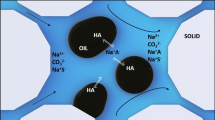Abstract
An experimental facility has been developed to study oil recovery using supercritical fluid systems of bulk and composite homogeneous porous materials in the mode of miscible and microbubble filtration of a mixture of oil and supercritical carbon dioxide. A device for visualizing the release of supercritical CO2 microbubbles from the experimental cell with a porous medium has been designed. The oil recovery by supercritical CO2 and rims of supercritical CO2 and water from a homogeneous bulk porous medium has been experimentally studied. It has been shown that the miscible mode of viscous oil recovery by supercritical CO2 is most efficient and the efficiency of viscous oil recovery in the microbubble mode can be increased using rims of supercritical CO2 and water. The mechanism of oil recovery enhancement in the region of microbubble recovery of viscous oil by supercritical CO2 is described.





Similar content being viewed by others
REFERENCES
G. S. Stepanova, Gas and Water–Gas Methods of Influence on Oil Reservoirs (Gazoil Press, Moscow, 2006) [in Russian].
M. L. Surguchev, Secondary and Tertiary Methods of Enhanced Oil Recovery (Nedra, Moscow, 1985) [in Russian].
E. A. Mamedov and A. M. Sal’nikov, “Structure of Residual Oil and Gas Reserves in Depleted Fields," Neftepromyslovoe Delo, No. 6, 6–7 (2016).
A. A. S. Aleidan, “Experimental and Simulation Studies to Evaluate the Improvement of Oil Recovery by Different Modes of CO2 Injection in Carbonate Reservoirs," Ph.D. Thesis (Texas A&M Univ., Texas, 2010).
S. Dayanand, “Characterization and Determination of CO2-Reservoir Oil Miscibility," in CO2 -Reservoir Oil Miscibility (Long Beach, California State Univ., 2019), pp. 19–36.
V. V. Zatsepin, “Experience off Industrial Application of Water–Gas Treatment Technology with Injection of a Water–Gas Mixture into a Reservoir," Neftepromyslovoe Delo, No. 1, pp. 8–10 (2007).
V. D. Lysenko, “Problems of Oil Reservoir Development during Gas Flooding and Alternating Injection of Water and Gas," Neftepromyslovoe Delo, No. 2, 4–15 (2007).
A. S. Al-Netaifi, “Experimental Investigation of CO2–Miscible Oil Recovery at Different Conditions," Ph.D. (Rajb, 2008).
S. G. Rassokhin, V. M. Troitskii, A. V. Mizin, and A. S. Rassokhin, “Modeling of Water–Gas Treatment of a Low-Permeability Oil Reservoir," Gazovaya Promyshlennost, No. 5, 40–44 (2009).
V. Ballint, The Use of Carbon Dioxide in Oil Production (Nedra, Moscow, 1977) [in Russian].
V. N. Khlebnikov, V. B. Gubanov, and A. M. Polishchuk, “Application of Slim-Tube Models for Physical Modeling of Oil Recovery by Miscible Agents. Part 2. Evaluation of the Possibility of Using Standard Filtration Equipment in the Slim Technique," Neftepromyslovoe Delo, No. 6, 32–38 (2014).
V. A. Volkov, P. E. Prokhorov, and A. N. Turapin, “Cyclic Gas Injection of Carbon Dioxide into Producing Wells to Enhance High-Viscosity Oil Production," Neft. Gaz. Novatsii, No. 4, 62–68 (2017).
V. A. Volkov, P. E. Prokhorov, and A. N. Turapin, “Technological Aspects of Cyclic Gas Injection of Carbon Dioxide to Increase High-Viscosity Oil Production," Neft. Gaz. Novatsii, No 8, 20–25 (2018).
G. S. Stepanova, “On the Effect of Adsorption and Desorption of Gas Micronuclei on the Filtration of Carbonated Fluid," Izv. Ross. Akad. Nauk, Mekh. Zhidk. Gaza, No. 5, 106–114 (2003).
B. Ren, Y. Xu, and B. Niu, “Laboratory Assessment and Field Pilot of near Miscible CO2 Injection for IOR and Storage in a Tight Oil Reservoir of Shengli Oilfield China," in Proc. of the Enhanced Oil Recovery Conf., Kuala Lumpur, Malaysia, July 2011; DOI: 10.2118/144108-MS.
L. Zuo and S. Benson, “Water Conformance and Mobility Control by CO2 Exsolution," in Proc. of the Collaborative Symp. on CO2 EOR between Universities in Texas and Norway, Houston, November 19–21, 2013 (Stanford Univ., Stanford, 2013), pp. 148–160.
D. N. Mikhailov, “Oil Recovery Process in the Presence of Microbubbles in the Filtration Flow," Prikl. Mekh. Tekh. Fiz. 53 (3), 68–83 (2012) [J. Appl. Mech. Tech. Phys. 53 (3), 366–378 (2012); https://doi.org/10.1134/S002189441203008X].
V. N. Kutrunov, “Mathematical Model of Oil Recovery by a Water–Gas Mixture," Fiz.-Mat. Model. Neft, Gaz, Energetika 1 (2), 163–172 (2015).
D. M. Tolstoi, “Molecular Theory of Sliding of Liquids on Solid Surfaces," Dokl. Akad. Nauk SSSR 85, 1089–1092 (1952).
B. A. Suleimanov, Features of Filtration of Heterogeneous Systems (Inst. of Comput. Res., Moscow–Izhevsk, 2007) [in Russian].
L. Meng, “Physical Modeling of Oil Recovery by Gas (Solvent) Using Core Reservoir and Slim Tube Models," Candidate Dissertation in Tech. Sci. (Moscow, 2016).
K. Sh. Yamaletdinova, “Development of Scientific Foundations and Methods of Development of Hard-To-Recover Oil Reserves in the Miscible Recovery Mode," Author’s Abstract, Doct. Dissertation in Tech. Sci. (Bashkir State Univ., Ufa 2006) [in Russian].
E. R. Khirazov, “Experimental Study of Capillary during Miscible Oil Recovery," Author’s Abstract, Candidate’s Dissertation in Tech. Sci. (Inst. of Problems of Transportation of Energy Resources, Ufa, 2008).
M. D. Rozenberg and S. A. Kundin, Multiphase Multi-Component Filtration in Oil and Gas Production (Nedra, Moscow, 1976) [in Russian].
D. A. Efros, Investigations of Filtration of Inhomogeneous Systems (Gostoptekhizdat, Leningrad, 1963) [in Russian].
Russian State Standard (GOST) No. 14249-89: Vessels and Apparatus. Norms and Methods of Strength Calculation (Standartinform, Moscow, 1989); Appl. May 18, 1989.
Author information
Authors and Affiliations
Corresponding author
Additional information
Translated from Prikladnaya Mekhanika i Tekhnicheskaya Fizika, 2021, Vol. 63, No. 1, pp. 89-96. https://doi.org/10.15372/PMTF20220112.
Rights and permissions
About this article
Cite this article
Radaev, A.V., Sabirzyanov, A.N. ENHANCING VISCOUS OIL RECOVERY IN THE MICROBUBBLE FILTRATION MODE USING SUPERCRITICAL FLUID SYSTEMS. J Appl Mech Tech Phy 63, 75–81 (2022). https://doi.org/10.1134/S0021894422010126
Received:
Revised:
Accepted:
Published:
Issue Date:
DOI: https://doi.org/10.1134/S0021894422010126




